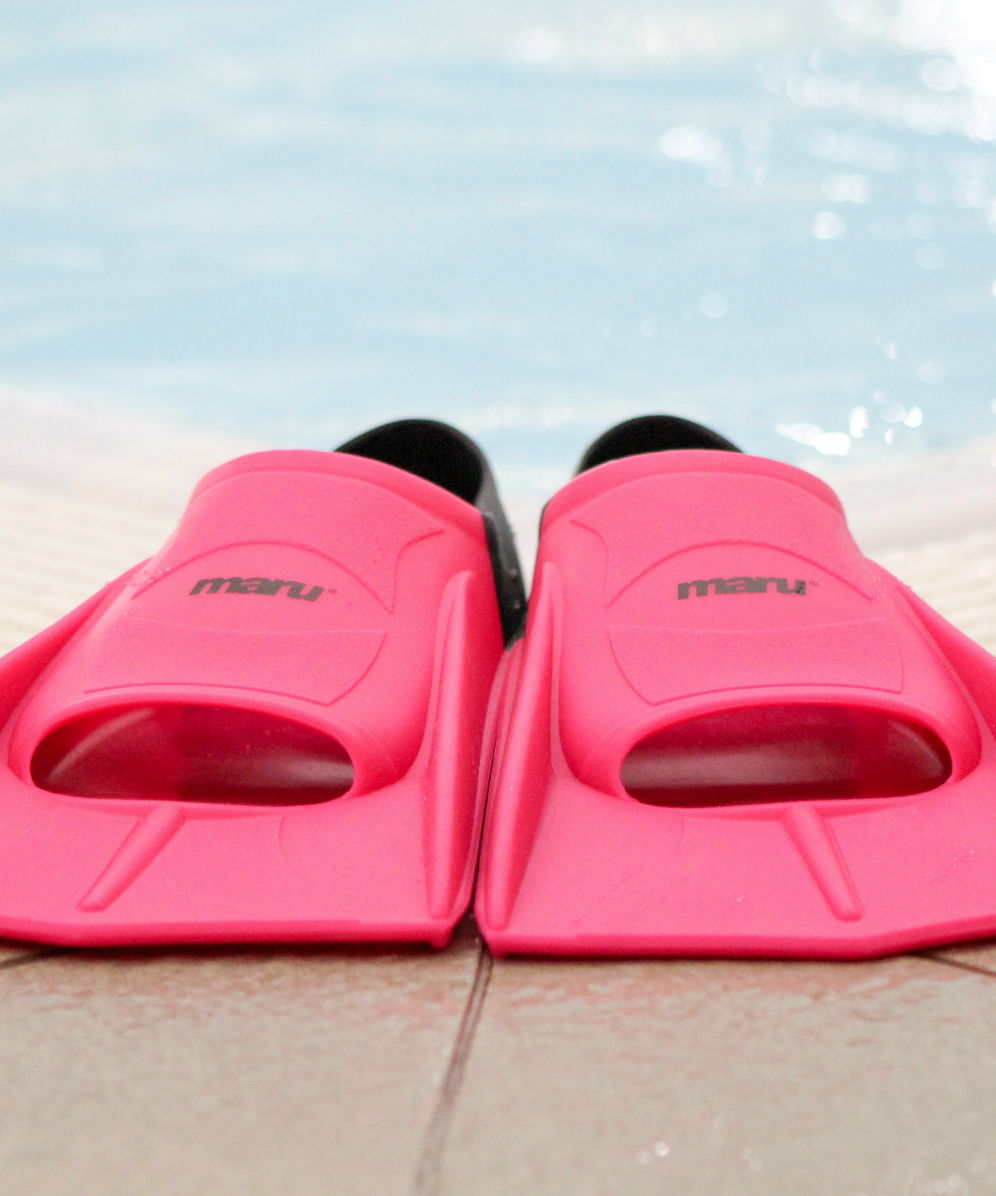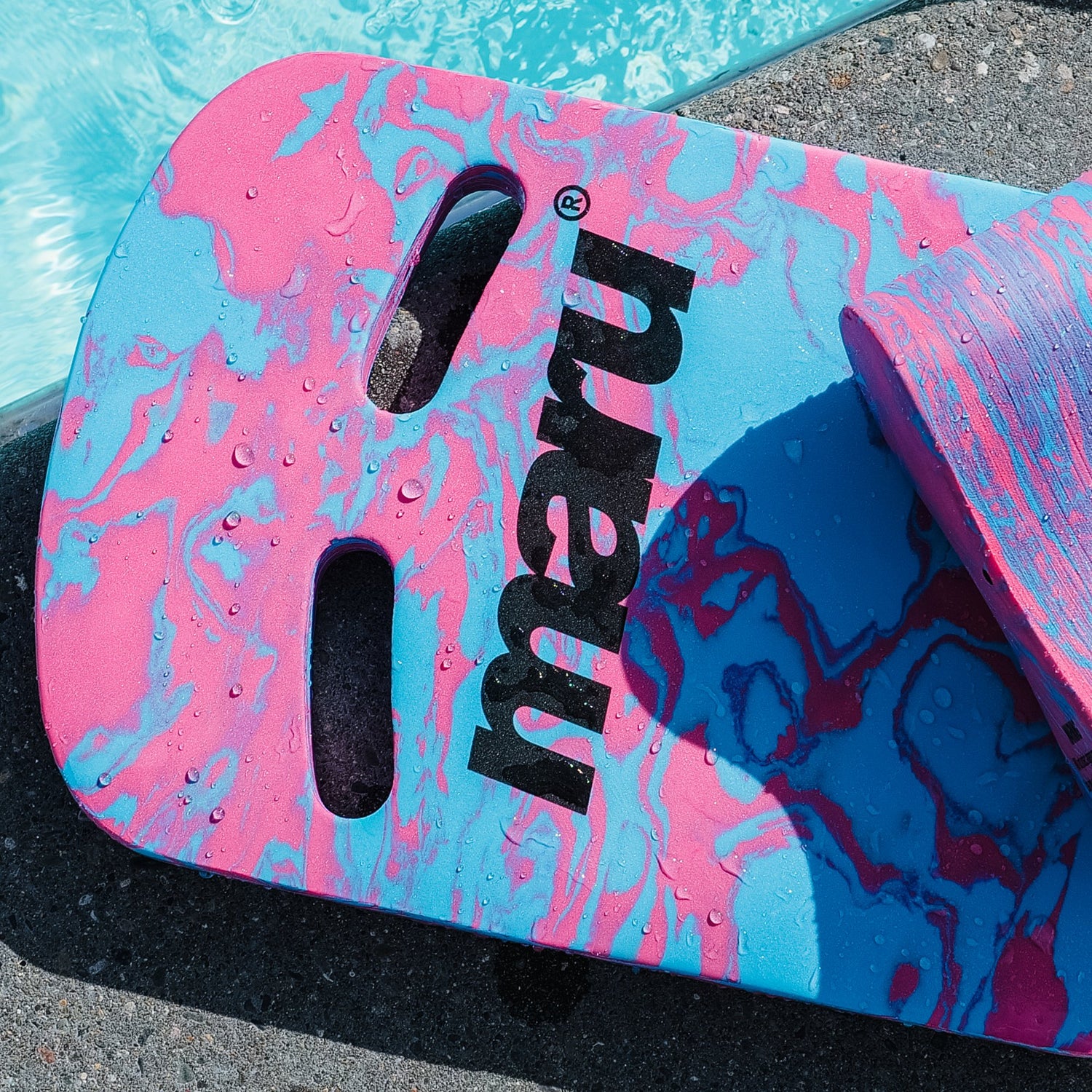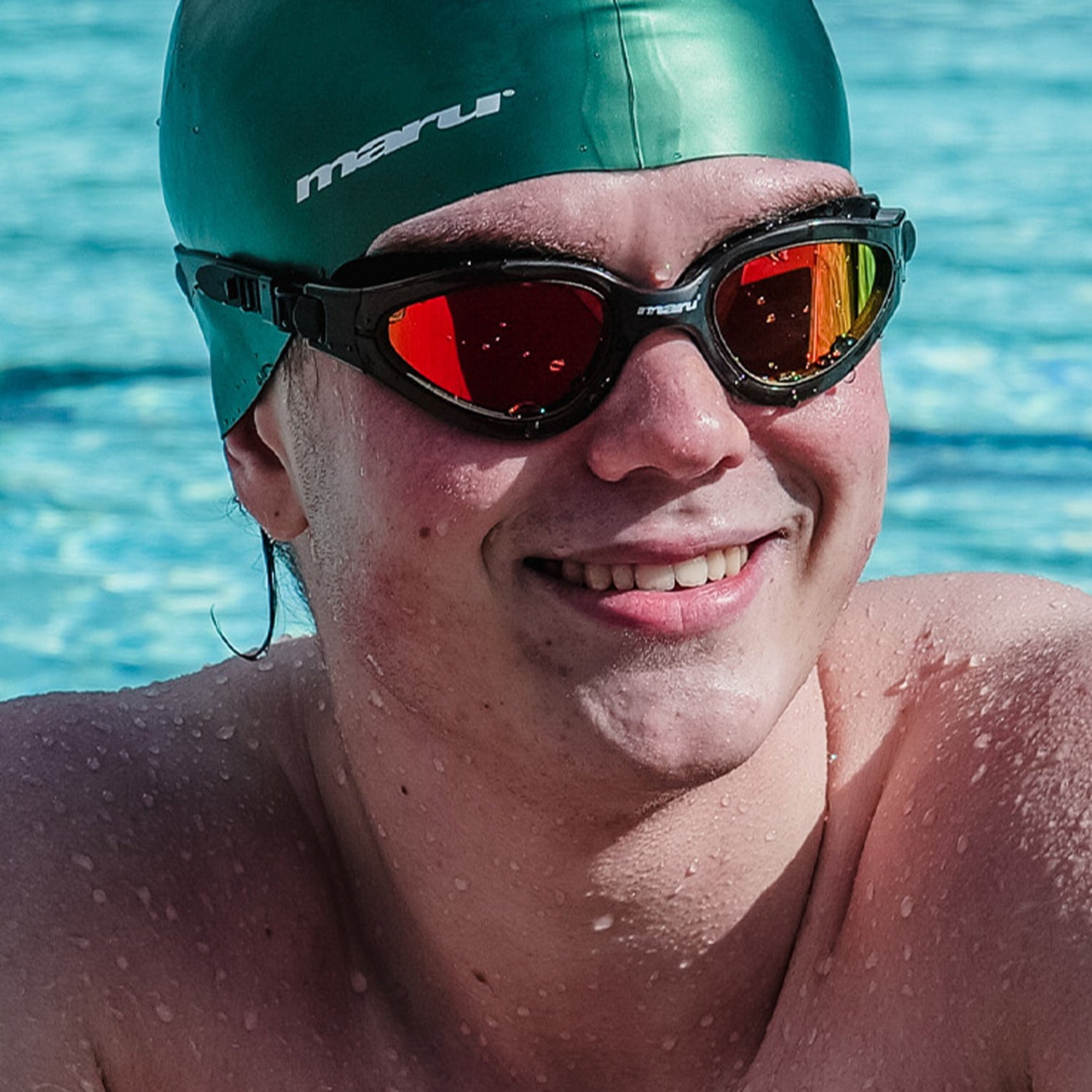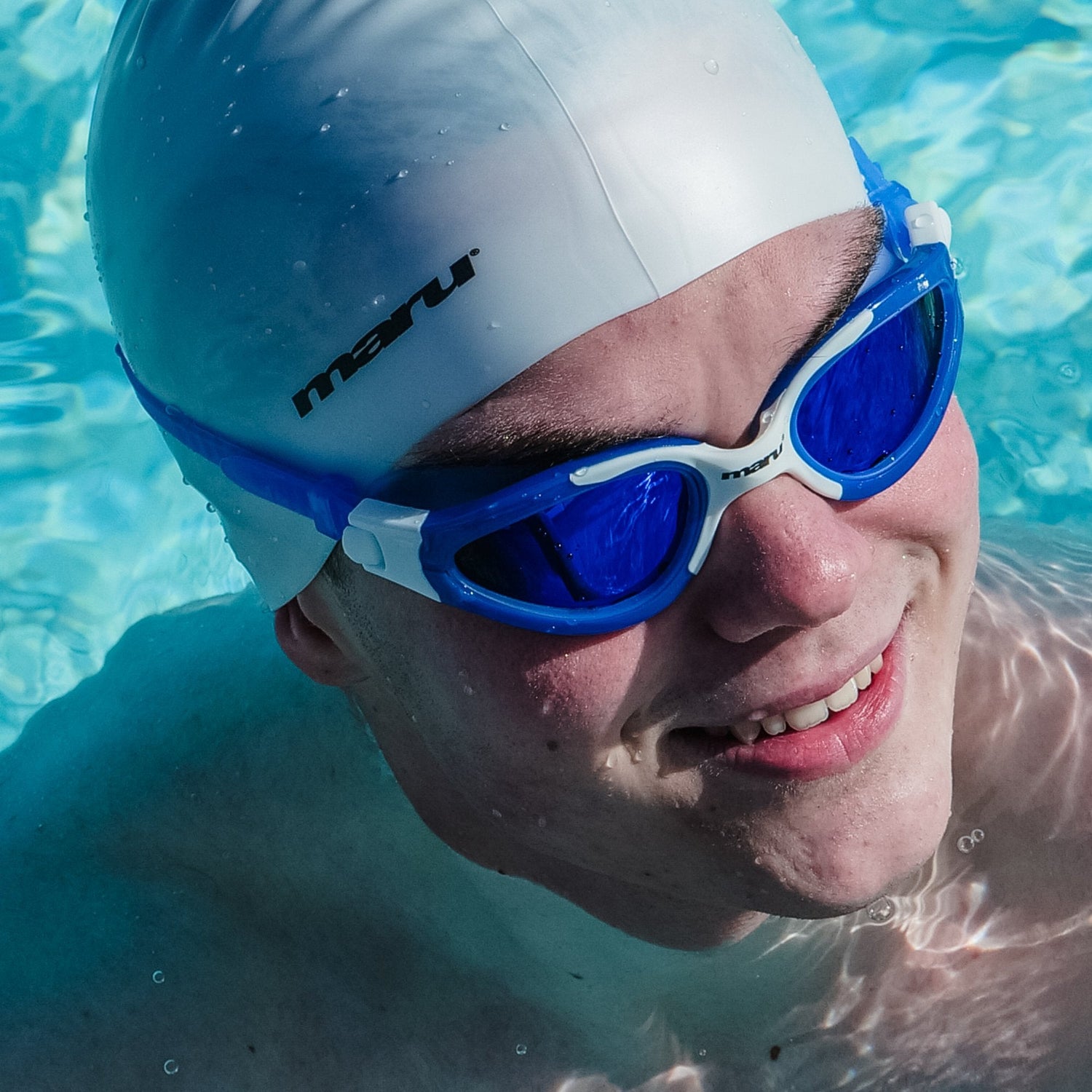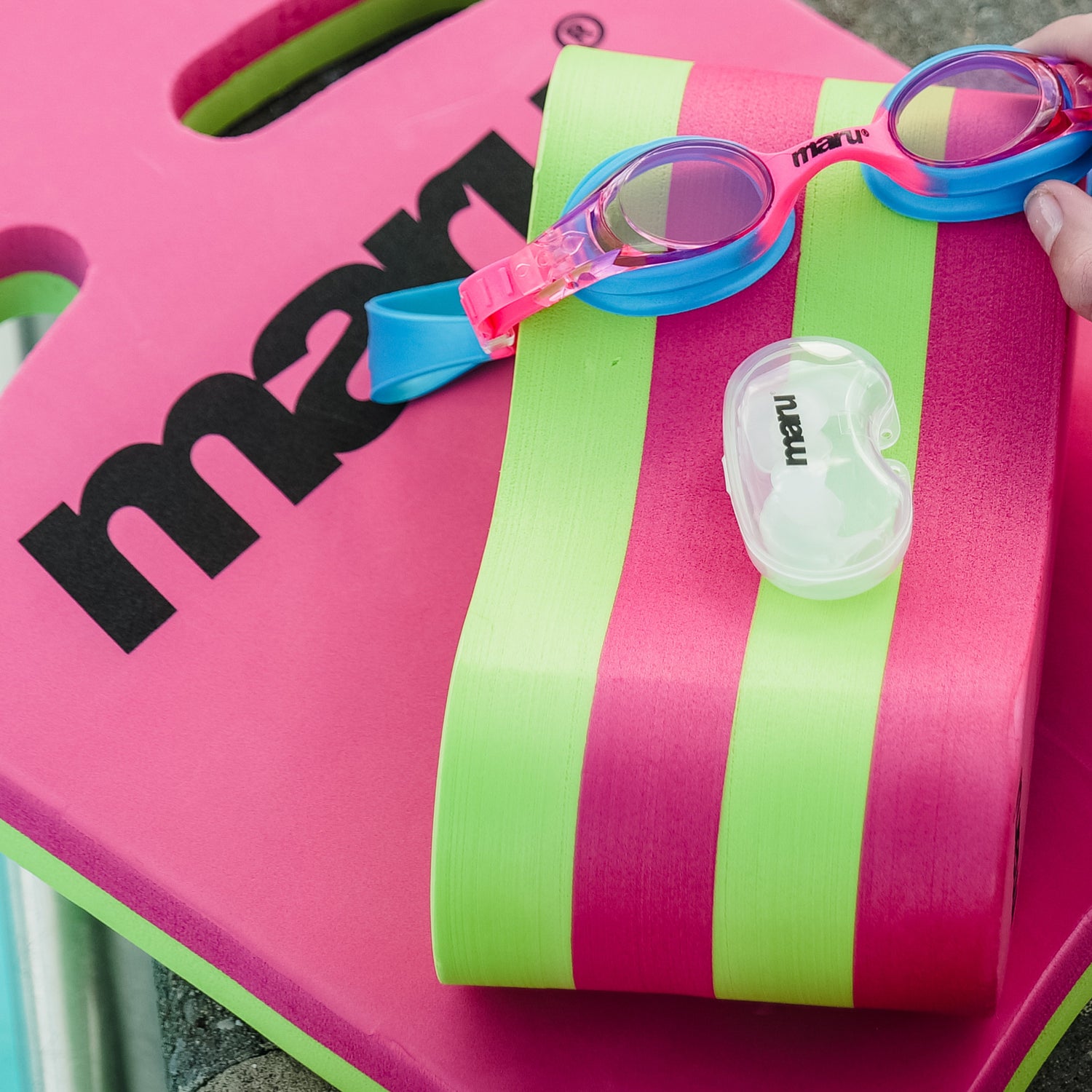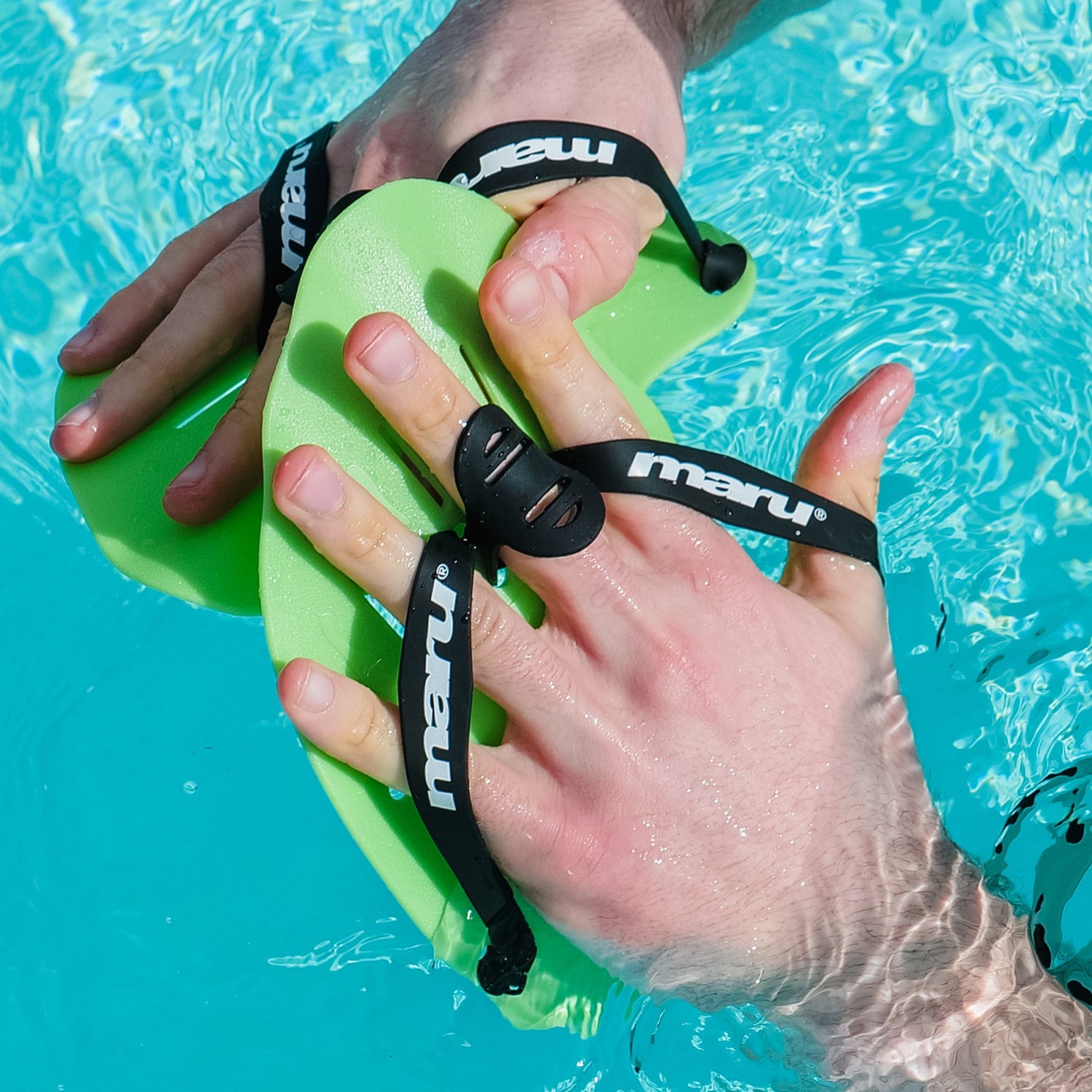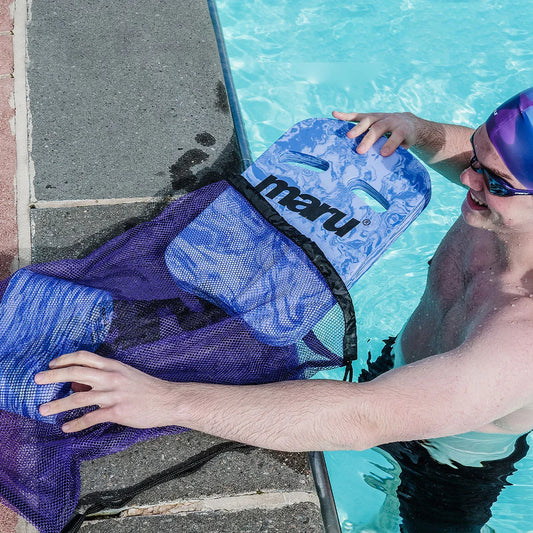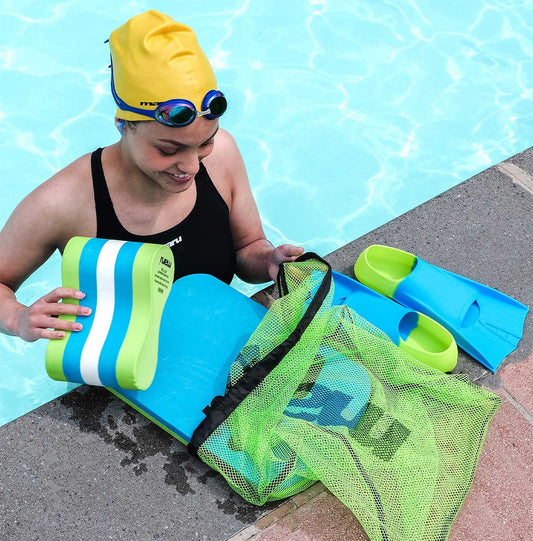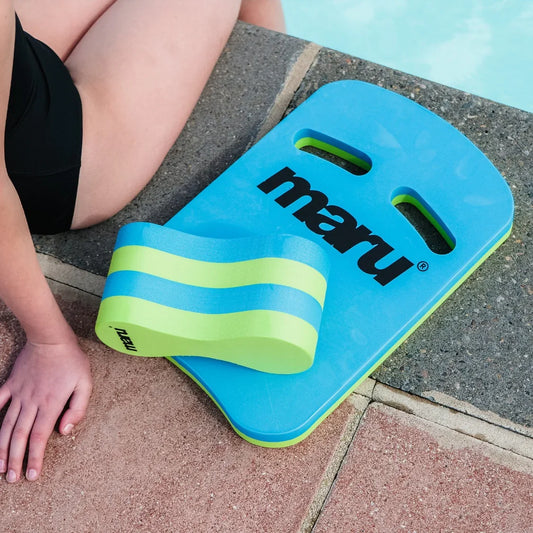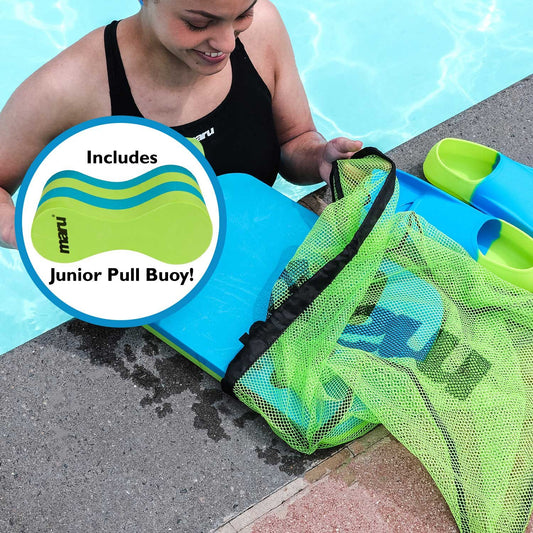Whether someone is just starting their swimming journey or training for competition, the right accessories can make all the difference. A coach sees this every day at the poolside, the right gear boosts comfort, builds confidence, and helps swimmers of all ages develop better technique. From protecting eyes and hair to refining stroke mechanics, swimming accessories serve practical purposes that support progress in the water.
This guide explores the essential swimming accessories that every swimmer should consider, from beginners taking their first lessons to experienced athletes looking to enhance their training. Understanding what each piece of equipment does and when to use it helps swimmers make informed choices that match their goals and ability level.
Do You Need Swim Goggles?
Goggles are arguably the most essential swimming accessory for anyone who spends time in the pool. They protect the eyes from chlorine and other pool chemicals whilst allowing clear underwater vision, which is crucial for navigation, safety, and proper technique development.
For children learning to swim, goggles help overcome the natural fear of putting their face in the water. When young swimmers can see clearly underwater, they feel more confident and relaxed, which accelerates their learning. Junior goggles typically feature smaller frames, softer seals, and easy-adjust straps that accommodate growing faces. Adult swimmers benefit from goggles designed for their specific needs whether that's wider peripheral vision for open water swimming, hydrodynamic profiles for racing, or comfortable seals for longer training sessions.
The fit matters enormously. Goggles should create a gentle seal around the eye sockets without being uncomfortably tight. Research from Swim England emphasises that proper equipment fit, including goggles, contributes to swimmer confidence and technique development, particularly during the learning phases.
Coach Tip: A swimmer should press the goggles gently against their face without using the strap if they stay in place with light suction for a few seconds, the fit is likely correct.
Browse the full range of Maru swim goggles to find the perfect pair for training or competition.
Do You Need a Swim Cap?
Swim caps serve multiple practical purposes that benefit swimmers of all levels. They reduce drag by keeping hair streamlined, protect hair from chlorine damage, keep stray hairs out of pool filters, and help maintain body heat during swimming sessions.
For children, swim caps make a noticeable difference in comfort and performance. Long hair that isn't secured can become a distraction, getting in the face and eyes during swimming. Silicone caps offer excellent durability and a secure fit, making them ideal for young swimmers who need reliable equipment that withstands regular use.
Adult swimmers often choose caps based on their hair type and swimming frequency. Regular pool users benefit from the protective element, as chlorine can be harsh on hair over time. Silicone caps provide a comfortable, watertight seal whilst being gentle on hair, making them suitable for both training and competition.
Coach Tip: To put on a cap easily, a swimmer should gather it like an accordion, place it on the forehead first, then stretch it back over the crown of the head — this method reduces pulling and makes the process much smoother.
Explore Maru swim caps designed for comfort and performance.
Do You Need Training Fins?
Training fins are powerful tools for developing leg strength, improving ankle flexibility, and refining kicking technique. They add resistance to leg movements whilst also providing extra propulsion, which allows swimmers to focus on other aspects of their stroke without worrying about maintaining body position.
For beginners and intermediate swimmers, fins help maintain proper body alignment in the water, making it easier to practice breathing patterns and arm movements. The added propulsion from fins keeps the hips elevated, which is often challenging for newer swimmers who tend to let their legs drop.
Studies on swimming equipment effectiveness show that fins can improve ankle flexibility and kick efficiency when used appropriately in training. Advanced swimmers use fins during specific drill sets to overload the leg muscles, building the power needed for fast racing starts and turns.
Children should use shorter, softer fins designed for junior feet. For pool training, short blade fins are ideal for swimmers of all ages, as they allow a more natural kick frequency and are perfect for technique work. A coach generally recommends short blade training fins over longer fins for most pool sessions, as they help develop proper kicking mechanics without overstressing the legs or disrupting stroke rhythm.
Coach Tip: Fins should fit snugly without pinching the toes or rubbing the heel, wearing them for too long without proper fit can cause blisters, so swimmers should build up their fin usage gradually.
Do You Need a Kickboard?
Kickboards remain a staple in swimming training for good reason. These buoyant accessories isolate the leg kick, allowing swimmers to focus entirely on lower body technique, power, and endurance. By eliminating the need to coordinate arm movements, kickboards help swimmers concentrate on generating propulsion from the hips and maintaining steady, rhythmic kicks.
For children and beginners, kickboards are valuable tools for isolating and developing fundamental kicking skills. By holding the board, swimmers can focus entirely on their leg technique without coordinating arm movements. This allows them to concentrate on generating propulsion from the hips and maintaining steady, rhythmic kicks. It's important to note that kickboards are training aids, not flotation devices, swimmers should already be comfortable in the water before using them for kick practice.
More experienced swimmers use kickboards for targeted conditioning work. Kick sets build cardiovascular fitness and leg strength, both essential for powerful starts, turns, and finishes. Swim England's technique guidance notes that focused kick training improves overall swimming efficiency, particularly in freestyle and backstroke.
Traditional rectangular kickboards work well for most training purposes, providing excellent buoyancy and a comfortable grip for swimmers of all ages and abilities. Their versatile design makes them suitable for everything from beginner kick drills to advanced conditioning sets.
Coach Tip: Swimmers should grip the kickboard loosely and keep their elbows slightly bent rather than locking their arms straight this creates a more natural body position and reduces shoulder strain during longer kick sets.
Do You Need a Pull Buoy?
Pull buoys transform the way swimmers train their upper body. These foam floats, positioned between the thighs, provide buoyancy to the lower body whilst preventing leg kicks. This forces swimmers to rely entirely on their arms and core for propulsion, making pull buoys invaluable for building upper body strength and refining stroke technique.
A coach often prescribes pull buoy sets for several reasons. They help swimmers develop a better feel for the water with their hands and forearms, improve body rotation, and strengthen the muscles used in the pull phase of each stroke. For swimmers recovering from leg injuries, pull buoys allow continued training without aggravating the injury.
Adult swimmers typically benefit most from pull buoys, though older children and teenagers working on competitive technique can use them effectively. Beginners might find them challenging initially, as they require reasonable core strength to maintain proper body position without kicking.
Research on swimming training equipment indicates that pull buoys help swimmers focus on arm stroke mechanics and develop upper body power, making them essential for well-rounded training programmes.
Coach Tip: When using a pull buoy, a swimmer should engage their core muscles to keep their hips high rather than relying solely on the buoy's flotation this builds the body awareness needed for efficient swimming.
Do You Need a Swimming Snorkel?
Centre-mount swimming snorkels have become increasingly popular training tools, and for good reason. Unlike traditional side-mounted snorkels used for recreational swimming, centre-mount snorkels attach to the front of the head and allow swimmers to breathe whilst maintaining perfect body alignment. This eliminates the need to turn the head for breathing, which can disrupt technique, particularly when learning or refining strokes.
For swimmers working on technique development, snorkels provide freedom to concentrate entirely on body position, rotation, and arm mechanics. A coach often introduces snorkels when teaching bilateral breathing or helping swimmers overcome lopsided breathing patterns that create imbalances in their stroke.
Competitive swimmers use snorkels during drill work and technique-focused sets. They're particularly valuable for perfecting underwater streamlines, dolphin kicks, and stroke timing without the interruption of breathing. According to British Swimming's training recommendations, snorkels help swimmers develop consistent technique by removing the rotation required for breathing.
Adult swimmers generally find snorkels easier to use than children, though confident young swimmers aged 10 and above can benefit from them during supervised training. Initially, breathing through a snorkel feels unusual, but most swimmers adapt quickly.
Coach Tip: A swimmer should start with short intervals when first using a snorkel and practice exhaling firmly through both nose and mouth to clear any water that enters the tube mastering this clearance technique builds confidence for longer training sets.
Do You Need a Mesh Bag?
Often overlooked but genuinely essential, a quality mesh bag makes every swim session more convenient and hygienic. Unlike solid bags, mesh allows wet swimming gear to breathe and drain, preventing the musty odours and mildew that develop when damp items sit enclosed. Chlorine-soaked equipment needs airflow to dry properly between sessions.
For parents with children in swimming lessons, a mesh bag simplifies the weekly routine. Everything needed for the pool goggles, cap, towel, and perhaps a few training accessories fits in one place that's easy to grab. The see-through nature of mesh also makes it simple to check that nothing's been forgotten before leaving home.
Adult swimmers who train regularly appreciate mesh bags that can accommodate their essential kit. A durable mesh bag withstands repeated use, exposure to pool chemicals, and the weight of wet equipment without tearing or losing shape.
Coach Tip: A swimmer should hang their mesh bag immediately after each session rather than leaving it in a car boot or closed locker this simple habit dramatically extends the life of both the bag and the swimming accessories inside.
Check out the Maru mesh bag designed for swimmers' practical needs.
Do You Need a Water Bottle for Swimming?
Staying hydrated during swimming might seem counterintuitive after all, swimmers are surrounded by water but dehydration is a real concern during training. Swimming is physically demanding exercise that produces sweat, even though swimmers don't notice it in the pool. The body loses fluids that must be replaced for optimal performance and recovery.
A coach always encourages swimmers to keep a water bottle poolside and sip regularly between sets. This habit maintains energy levels, helps regulate body temperature, and supports muscle function throughout the session. Children particularly need reminders to drink, as they often get so engrossed in their lessons or play that they ignore thirst signals.
For pool use, bottles should have secure, leak-proof lids and be clearly labelled with the swimmer's name. A 750ml capacity is ideal for most training sessions, providing enough hydration without being too bulky to carry poolside. The bottle should be easy to open and close, allowing swimmers to take quick sips between sets without fumbling or wasting valuable training time.
UK Coaching guidance emphasises the importance of hydration in athletic performance, noting that even mild dehydration can impair concentration and physical output.
Coach Tip: A swimmer should aim to drink small amounts regularly throughout their session rather than gulping large quantities at once, steady hydration maintains performance better than infrequent large drinks.
Do You Need Hand Paddles?
Hand paddles are advanced training tools that increase resistance during the arm pull, building upper body strength and reinforcing proper hand position. These flat accessories attach to the hands with adjustable straps, creating a larger surface area that catches more water with each stroke.
Research demonstrates that hand paddles, when used correctly, can improve stroke efficiency and develop the specific strength needed for faster swimming. They help swimmers feel the water better and develop a more effective pull pattern, particularly in freestyle and backstroke. Guidance from SwimNow suggests that paddles should be introduced gradually and matched appropriately to swimmer ability and hand size.
A coach introduces paddles carefully, as they significantly increase the load on shoulder joints and muscles. Swimmers need reasonable technique and shoulder stability before adding paddles to their training. Generally, paddles suit intermediate to advanced swimmers rather than beginners, though older teenagers working on competitive swimming can use them under proper supervision.
Paddle size matters, bigger isn't necessarily better. Oversized paddles that are too large for a swimmer's hand size and strength level can cause injury. Most swimmers should start with appropriately sized paddles and focus on maintaining good technique rather than simply powering through sets. Paddles with adjustable straps offer a secure, customisable fit that stays comfortably in place during training.
Adult swimmers benefit from varied paddle use, some sessions with paddles for strength, many sessions without them for natural feel. Young swimmers should only use paddles under proper coach supervision to ensure correct technique and avoid injury.
Coach Tip: When using paddles, a swimmer should maintain their normal stroke rate and technique rather than slowing down or altering their movement pattern, if technique breaks down, the paddles are either too large or being used for too long.
Explore Maru hand paddles designed for effective strength training.
Do You Need Swimming Ear Plugs?
Swimming ear plugs are essential accessories for swimmers who experience discomfort or are prone to ear infections. They create a watertight seal that prevents water from entering the ear canal, protecting against conditions like swimmer's ear (otitis externa) and general ear discomfort during and after swimming sessions.
For children, ear plugs can be particularly important. Young swimmers with a history of ear infections or those with grommets fitted should use ear plugs as recommended by their doctor. Many children find that ear plugs increase their comfort in the water, allowing them to focus on learning and enjoying swimming rather than worrying about water in their ears.
Adult swimmers benefit from ear plugs in various situations. Regular pool users who train frequently may develop sensitivity to water exposure, whilst open water swimmers appreciate the protection ear plugs provide in colder conditions. Some swimmers simply prefer the sensation of keeping their ears dry, which can improve their overall confidence and enjoyment in the water.
Quality ear plugs should fit securely without causing discomfort, stay in place during active swimming, and be easy to insert and remove. Reusable silicone ear plugs offer durability and can be moulded to fit individual ear shapes, making them a practical long-term investment.
Coach Tip: A swimmer should ensure their ear plugs fit properly before getting in the water, a quick test is to gently tug on them to check they're secure, as loose-fitting plugs can fall out mid-session or fail to keep water out effectively.
Discover Maru swimming ear plugs designed for comfortable water protection.
Choosing the Right Accessories
The best swimming accessories depend entirely on individual needs, ability level, and swimming goals. Beginners typically start with essentials: goggles, a cap, and perhaps a kickboard. As skills develop, adding fins, pull buoys, and other training tools helps target specific areas for improvement.
For those starting out or looking to build a complete kit efficiently, swim bundles offer excellent value by combining essential accessories in ready-made packages. These curated sets take the guesswork out of choosing compatible equipment and ensure swimmers have everything needed for effective training from day one.
Children's swimming accessories should prioritise comfort and confidence-building. Equipment that fits properly and doesn't cause discomfort encourages young swimmers to enjoy their time in the water, which is fundamental to long-term participation and skill development.
Adult swimmers can be more selective, choosing accessories that support specific training objectives. A recreational swimmer might need only goggles and a cap, whilst a competitive swimmer benefits from a full range of training equipment. Bundles designed for different ability levels help swimmers access the right combination of accessories without purchasing items individually.
Quality matters across all accessories. Well-made equipment lasts longer, performs better, and provides a more comfortable swimming experience. Investing in reliable swimming gear from trusted manufacturers like Maru ensures that accessories serve their purpose session after session.
The right accessories remove barriers and create opportunities. They help swimmers feel comfortable, train effectively, and enjoy their time in the water, whether that's a child's first nervous lesson or an experienced athlete's dedicated training session. Each piece of equipment serves a purpose, and understanding that purpose helps swimmers build a kit that truly supports their aquatic journey.


